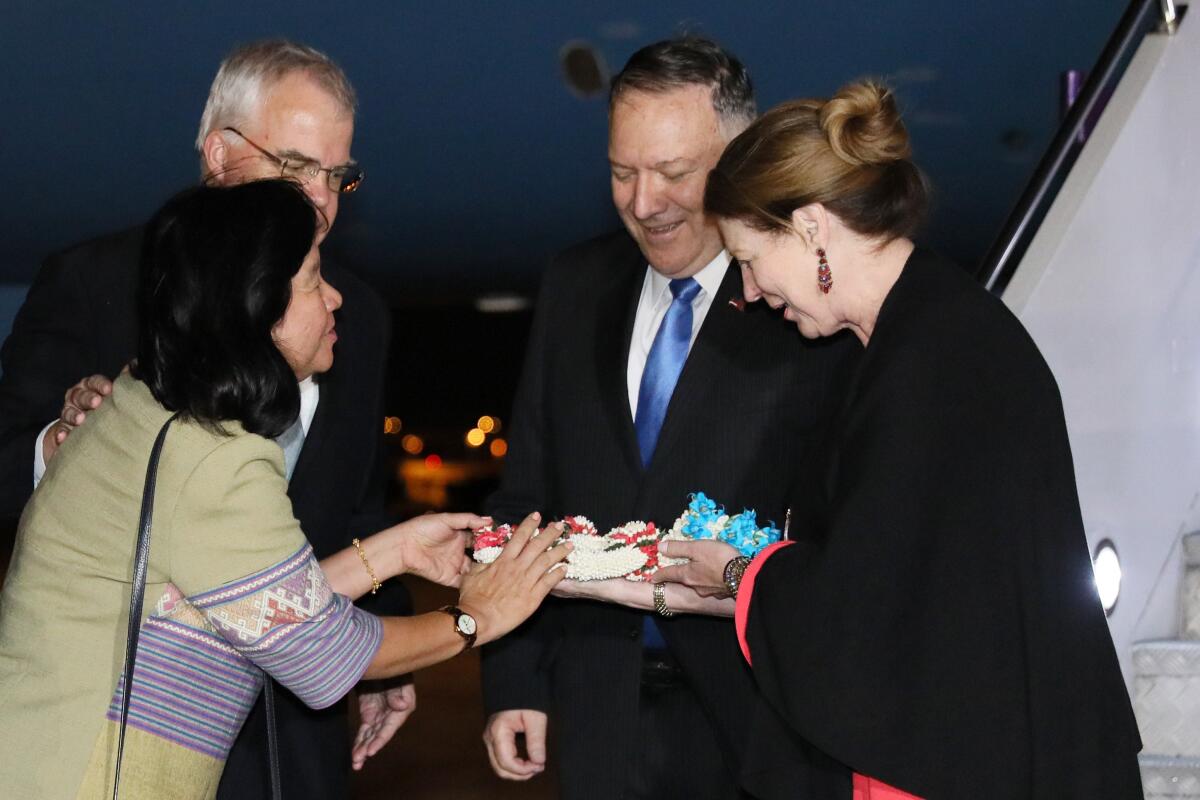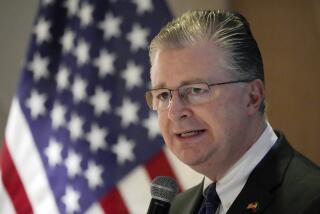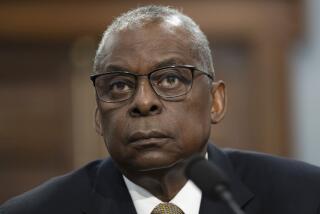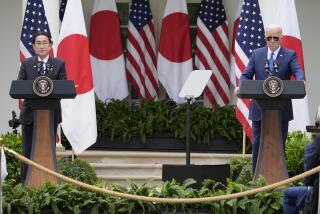Pompeo seeks to restore U.S. influence in Southeast Asia amid China’s rise

- Share via
BANGKOK, Thailand — Against a backdrop of China’s rising economic and military power, Secretary of State Michael R. Pompeo arrived in the Thai capital of Bangkok this week with a difficult mission: Try to win back lost ground in Southeast Asia, a region once dominated by the U.S.
Under President Trump, U.S. leverage in Southeast Asia has continued a slide that began during the Obama administration. Trump’s early decision to pull out of the 12-nation Trans-Pacific Partnership trade agreement — President Obama’s attempt to cement American influence and counter China’s in the region — angered and frustrated the U.S. allies, who to the surprise of some decided to forge ahead on the trade agreement without the U.S.
The United States’ waning power is also apparent in the Trump administration’s fight to pressure and isolate the Chinese communications giant Huawei, a campaign that has drawn little support from Southeast Asian nations. And several of those countries are increasingly nervous about getting caught up in Washington’s trade war with China.
Pompeo, who will meet with top government officials from 10 Southeast Asian nations representing 650 million people, said he was confident the Trump administration’s efforts were deepening and widening U.S. engagement in a strategically important part of the world.
But he downplayed the U.S.-China rivalry, saying his goal was not to win “back” allies, and telling reporters traveling with him that it was “rude” to suggest some countries in the region were “vassal states” in the “clutches of China.”
“They are looking for partners,” he said. “It’s not about luring them back.”
On Thursday, Pompeo stepped lightly when he opened the ASEAN conference here, avoiding mention of China when he said the U.S. will “not ever” ask a nation in the region “to choose between countries.”
“Our engagement in this region has not been and will not be a zero-sum exercise,” Pompeo added. “Our interests simply naturally converge with yours to our mutual benefit.”
Pompeo is also attempting to solidify another initiative of his tenure: creation of the so-called Indo-Pacific region, which portends to redraw boundaries to stretch from the U.S. West Coast to Japan, down through Southeast Asia to Australia and west across another ocean to India. It is replacing the familiar Asia-Pacific region and incorporates India (while sidelining Pakistan) to expand U.S. heft against China.
China has not been shy about pouring tens of billions of dollars into infrastructure projects as part of its mammoth Belt and Road initiative, promising to boost transport systems and connectivity to help drive a sustained period of growth and stepping in where the U.S. often isn’t.
Thanks in part to China’s investment, the Assn. of Southeast Asian Nations, or ASEAN, has posted a combined economic-output growth of 50% in the last decade.
But China’s rise has sparked some backlash in the region. Malaysia canceled certain Belt and Road projects because of what it viewed as unfavorable terms. Other countries are worried about Beijing’s efforts to use infrastructure projects for military purposes.
The South China Sea is a case in point. China has steadily built up and is militarizing the sea’s scattered islands and shoals, which other nations also claim. The maritime and territorial disputes with Beijing have roiled the region.
Pompeo said the Cambodian government, in a meeting Thursday, denied reports that it was prepared to allow Chinese troops to use a Cambodian naval base, which would have been the People’s Liberation Army’s first outpost in Southeast Asia. Pompeo urged other countries to follow Cambodia’s example.
China’s inroads, however, are undeniable, as is America’s decline.
After Trump in 2017 walked away from the TPP trade agreement, U.S. meat and agricultural exports to those nations suffered, experts said.
Zachary Abuza, a professor at the National War College in Washington, described the TPP withdrawal as a decision that U.S. relations with Southeast Asia “will never recover from.”
“No one really has a lot of faith that America is staying in the region or that our presence in the region is durable,” Abuza said. “We’re looking so transactional right now. We walk away from agreements we sign. We don’t look reliable.”
Many Southeast Asian governments have also recoiled at what they see as U.S. efforts to force them to take sides in the trade dispute with China.
Apart from Vietnam, no country in the region has agreed to join the U.S. boycott of Huawei, despite the Trump administration’s warnings that the U.S. could cease sharing sensitive information with countries that use the company’s technology.
The two U.S. treaty allies in the region – Thailand and the Philippines – are both headed by governments that have sought closer ties with China. Huawei is testing ultra-fast 5G service in Thailand, and next month the Philippines is expected to roll out Southeast Asia’s first 5G mobile data service, powered by Huawei technology.
Philippine officials told The Times in June they had found no evidence to support U.S. allegations that Huawei’s equipment could be a Trojan horse for Chinese spies.
“It’s not that the argument [on Huawei] is misguided or inaccurate; it’s just late, and there was never an American alternative,” said Benjamin Zawacki, a Bangkok-based analyst and author of the 2017 book “Thailand: Shifting Ground Between the U.S. and a Rising China.”
“On whatever issue you want to point to…there’s almost none in which the U.S. is advancing its interests in the region at a faster pace than China,” Zawacki said.
Here in Bangkok, Pompeo’s Chinese counterpart, Wang Yi, appeared as conciliatory as America’s top diplomat. After the two held a 30-minute bilateral meeting, Wang emerged to say that “no matter how many problems, it is important for both sides to sit down and have face-to-face discussions.”
Pompeo said later on Twitter that he was ready to cooperate with China “when it advances U.S. interests.” And in a news conference Thursday evening, he said: “We were also very candid about the places we are hoping China will behave in the ways that they are not behaving.”
Pompeo’s visit to Thailand also comes weeks after the formation of a new government there following the first election since a 2014 coup. The March election was marred by legal attacks against leading opposition parties and held under a new constitution that gave the army extensive power to manipulate the apportionment of parliamentary seats, allowing the incumbent prime minister, former Gen. Prayuth Chan-ocha, to remain in power.
Critics of the military have also come under attack in Thailand and overseas, with several prominent dissidents killed or arrested in recent months.
Over the last decade, and particularly since the coup, Thailand has expanded military relations with China, conducting joint exercises with every branch of the People’s Liberation Army and increasing weapons purchases from China.
Wary of pushing Thailand further away, the U.S. has refrained from criticizing Thailand’s election or the attacks against dissidents. Even if he doesn’t explicitly endorse the outcome, “Pompeo’s presence will give the Thais what they are looking for, which is belated closure on the elections,” Zawacki said.
In Washington, the Pentagon is reportedly pushing for a full normalization of relations with Thailand. After the 2014 army coup, the United States scaled back the annual military exercise it co-hosts with Thailand, known as Cobra Gold, and suspended $3.5 million in military aid.
But Cobra Gold has been restored to pre-coup levels, and in a sign of U.S. eagerness to patch relations, Trump hosted Prayuth in Washington and last year then-Defense Secretary James N. Mattis met twice with his Thai counterpart, Prawit Wongsuwan.
“The Trump administration wants to normalize ties again,” said Paul Chambers, a lecturer at Naresuan University in Thailand. “For the Trump administration, geopolitical concerns about China far outweigh any worries about a lack of democracy and state respect for human rights in Thailand by the military.”
A senior State Department official -- aware the administration is seen as lax on human rights issues -- said U.S. officials believed the Thai government had made significant progress worthy of a U.S. diplomatic embrace.
“I think of it as more of a process,” said the official, who briefed reporters on the condition he not be identified. “We can always work on where we are in terms of democracy, and I look forward to working with the Thais further on this.”
Pompeo, with Thai Foreign Minister Don Pramudwinai at his side, on Thursday praised the new Thai government as “a big step in the right direction.”
Bengali reported from Singapore.
More to Read
Sign up for Essential California
The most important California stories and recommendations in your inbox every morning.
You may occasionally receive promotional content from the Los Angeles Times.















